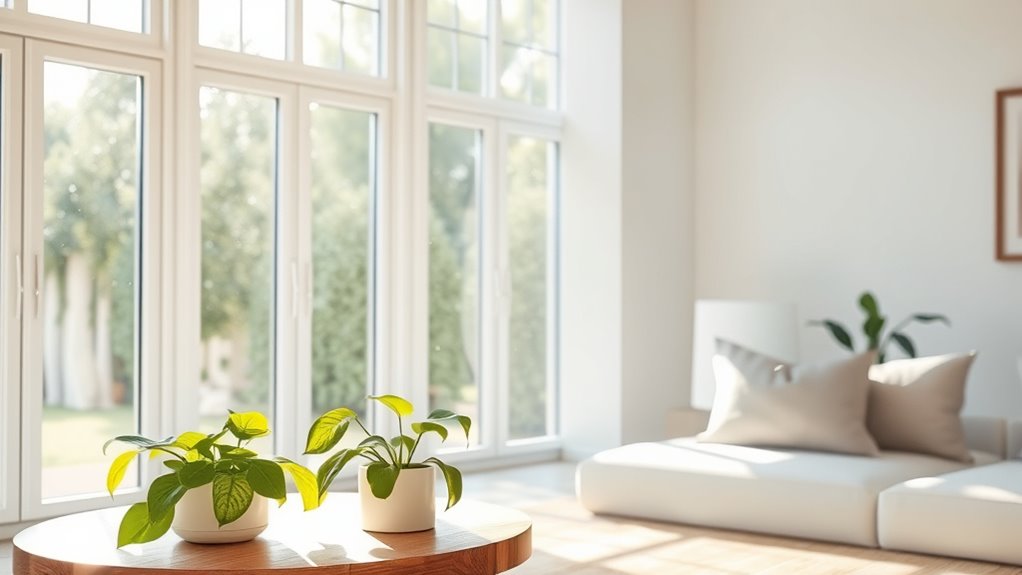If your home has poor air quality, it can make you sick, trigger allergies, and reduce your comfort. Common sources like cleaning products, pet dander, cooking fumes, and building materials can release pollutants indoors. Proper ventilation, air purifiers, and controlling pollution sources help improve air quality. Ensuring fresh air flows in and harmful particles are removed can make a big difference. Keep going to discover simple ways to breathe easier and stay healthier at home.
Key Takeaways
- Poor indoor air quality from pollutants like dust, mold, or chemicals can cause health issues such as allergies and respiratory problems.
- Inadequate ventilation traps indoor contaminants, leading to higher exposure and potential sickness.
- Sources like cleaning products, pet dander, and building materials release harmful chemicals into your home environment.
- Using air purifiers and maintaining proper ventilation helps reduce airborne pollutants and improve health.
- Regularly managing indoor sources of pollution is essential to prevent your home from negatively impacting your well-being.

Have you ever wondered how the air inside your home affects your health and comfort? The truth is, indoor air quality plays a vital role in your well-being, yet many overlook how pollutants build up and linger indoors. One of the most effective ways to improve air quality is by implementing proper ventilation strategies. These methods help bring in fresh air and remove stale, contaminated air, reducing the concentration of indoor pollutants. Simple actions like opening windows, using exhaust fans, or installing mechanical ventilation systems can make a significant difference. Proper ventilation ensures that harmful substances don’t accumulate, making your home healthier and more comfortable. Additionally, integrating air purification devices such as air purifiers can further enhance indoor air quality by actively removing airborne contaminants. Understanding pollutant sources is essential to managing indoor air quality. Pollutants originate from various sources inside your home, including cleaning products, furniture, pet dander, cooking fumes, and even building materials. These sources release chemicals and particles into the air, which can irritate your respiratory system, trigger allergies, or worsen asthma symptoms. Identifying and minimizing these sources is the first step toward cleaner indoor air. For example, choosing low-VOC paints, avoiding smoking indoors, and regularly cleaning to reduce dust and pet dander can considerably cut down pollutant levels. Additionally, maintaining appliances like stoves and fireplaces ensures they don’t leak gases that could compromise air quality.
Ventilation strategies are your frontline defense against indoor pollutants. An effective approach involves not only introducing fresh outdoor air but also removing contaminated indoor air. Mechanical ventilation systems, such as heat recovery ventilators (HRVs) or energy recovery ventilators (ERVs), are particularly useful for maintaining a consistent exchange of air, especially during extreme weather when opening windows isn’t practical. These systems help control humidity, reduce mold growth, and limit the buildup of airborne chemicals. In naturally ventilated homes, opening windows and doors at strategic times can also improve air flow. The key is to balance ventilation to guarantee a continuous supply of clean air without letting in outdoor pollutants or causing energy loss.
Frequently Asked Questions
How Often Should I Replace Air Filters in My Home?
You should replace your air filters every 1 to 3 months, depending on your home’s environment and filter lifespan. Regular HVAC maintenance includes changing filters to guarantee good indoor air quality. If you have pets or allergies, consider replacing filters more frequently. Check your filter’s manufacturer recommendations and inspect it monthly to keep your system running efficiently and maintain a healthy indoor environment.
Can Houseplants Improve Indoor Air Quality?
Imagine houseplants transforming your space into a breath of fresh inspiration so powerful, it’s like having a personal air purifier in every corner. Houseplants do provide plant benefits, actively improving air quality by removing toxins and increasing humidity. While they won’t completely replace HVAC filters, their presence can markedly boost indoor air quality, making your home healthier and more inviting. So, adding plants is a simple, natural step to enhance your environment.
What Are Common Sources of Indoor Air Pollution?
You should know that common sources of indoor air pollution include VOC emissions from paints, cleaning products, and furniture. Mold growth also contributes considerably, especially in damp areas. These pollutants can cause health issues and reduce air quality. To improve your home’s air, ventilate regularly, fix leaks promptly, and choose low-VOC products. Recognizing and addressing these sources helps keep your indoor environment healthier and safer.
Do Air Purifiers Effectively Eliminate All Indoor Pollutants?
Air purifiers with HEPA filters can *thoroughly* reduce many indoor pollutants, but they don’t eliminate all. They are effective at capturing airborne particles like dust, pollen, and pet dander, and some models also target VOC removal. However, they can’t remove gases or chemicals that linger on surfaces or in the air continuously. For *complete* indoor air quality, combine air purifiers with good ventilation and source control.
How Does Humidity Affect Indoor Air Quality?
Humidity levels directly impact your indoor air quality. If humidity is too high, it creates an ideal environment for mold growth, which can worsen allergies and respiratory issues. Conversely, low humidity can cause dry skin and irritate your throat. Maintaining balanced humidity levels helps prevent mold growth and keeps your indoor air healthier, making your home a more comfortable and safer place to breathe.
Conclusion
Remember, your home’s air quality directly impacts your health, so don’t ignore the signs. Regularly ventilate, keep things clean, and use air purifiers when needed. Small steps can make a big difference in creating a healthier living space. After all, an ounce of prevention is worth a pound of cure—invest in your indoor air quality now, and breathe easier tomorrow. Your health is worth it, so take action today!









